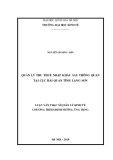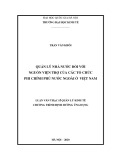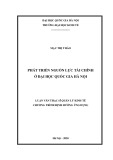
1905, Robert H. Montgomery gave his opinion on the content of the internal inspection
system that later evolved into internal control in “Auditing - Theory and Practice”. In 1929,
the announcement of the Federal Reserve System (FED) for the first time introduced the
concept of internal control. In 1936, American Institute of Certified Public Accountants
(AICPA) also introduced the concept of internal control, supplementing the objective of
internal control which is to ensure accurate accounting data. Later, in the book “Modern
Internal Audit - Evaluation of activities and control systems” by Victor Z. Brink and Herbert
Witt (1941), the ICS was also mentioned with relatively full comments of internal audit. In
1949, AICPA added the objective of promoting effective operation and encouraging the
compliance of management policies into the concept of internal control. After 1949, AICPA
also issued many audit standards addressing different concepts and aspects of internal control.
In 1958, in the report on SAP 29 (Statement on Auditing Procedure Statement) of the
Committee on Auditing Procedure (CAP) under AICPA, it was the first time to distinguish
internal control in terms of management and accounting. In 1962, this organization issued
SAP 33, further clarifying the concept of internal control in broad sense; since then, the
auditing standards have been developed, which require the auditing company to limit the
internal research on accounting. In 1972, CAP issued SAP 54 “Understanding and evaluating
internal control”, which introduced four accounting control procedures. After that, AICPA
issued Statement on Auditing Standard (SAS) to replace SAP, in which SAS1 (established in
1973) on the responsibilities of auditors review SAP 54 and provide a more complete
framework for accounting control. In 1976, Alvin A. Arens and James K. Loebbecke in
“Auditing: An Integrated Approach” gave the reason for companies to build an ICS. In 1992,
the COSO Report, “Internal Control - Integrated Framework”, became the theoretical
framework for ICS which was studied and presented in a complete and systematic manner.
Research on internal control in the relationship of financial accounting
information quality of listed companies was conducted through a number of studies such as
study of the US Committee of Sponsoring in 1987; Defond's research (1991); Angella.A’s
study (2009); J. Altamuro’s research (2010); N. KLai’s research (2011); Alvin A.Arens’s
research (2012). The above studies all show the important impact of internal control on the
quality of financial accounting information of listed companies.
Research on internal control in the banking sector: Applying regulations on
internal control of COSO to CIs and banks, the Basel Report of the Basel Committee































